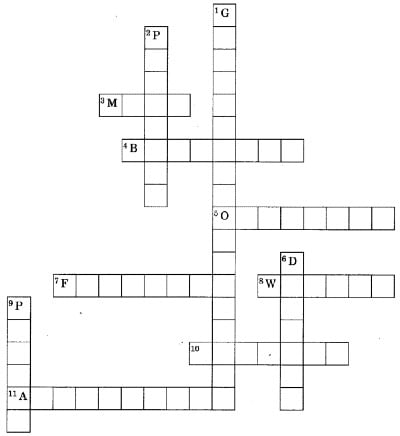Gravitation Class 9 Worksheet Science Chapter 9
| Table of contents |

|
| Multiple Choice Questions |

|
| Fill in the blank |

|
| Crossword |

|
| Very Short Answer Questions |

|
Multiple Choice Questions
Q1: If the area of an object is less than the pressure acting on that object will be
(a) Less
(b) More
(c) Independent of area
(d) None of the above
Q2: Even though stone also attracts earth towards itself, earth does not move
(a) Because of greater mass of earth
(b) Because of lesser mass of stone
(c) Force exerted by stone is less
(d) Force exerted earth is large
Q3: Which of the statements is correct?
(a) Mass is constant and weight is variable
(b) Mass is variable and weight is constant.
(c) Both Mass and weight are variable
(d) Both Mass and weight are constant.
Q4: Weight of the object is:
(a) More at the equator and less at poles
(b) More at poles and less at equator
(c) Same at poles and equator
(d) Depend on Mass of the object
Q5: An object is put one by one in three liquids having different densities. The object floats with 1/9, 2/11 and 3/7 parts of their volumes outside the liquid surface in liquids of densities d1, d2 and d3respectively. Which of the following statement is correct?
(a) d1 > d2 > d3
(b) d1 > d2 < d3
(c) d1 < d2 > d3
(d) d1 < d2 < d3
Q6: In the relation F = GM mld2, the quantity G
(a) depends on the value ofg at the place of observation
(b) is used only when the Earth is one of the two masses
(c) is greatest at the surface of the Earth
(d) is universal constant of nature
Q7: Law of gravitation gives the gravitational force between
(a) the Earth and a point mass only
(b) the Earth and Sun only
(c) any two bodies having some mass
(d) two charged bodies only
Q8: The value of quantity G in the law of gravitation
(a) depends on mass of Earth only
(b) depends on radius of Earth only
(c) depends on both mass and radius of Earth
(d) is independent of mass and radius of the Earth
Q9: Two particles are placed at some distance. If the mass of each of the two particles is doubled, keeping the distance between them unchanged, the value of gravitational force between them will be
(a) 1/4 times
(b) 4 times
(c) 1/2 times
(d) unchanged
Q10: The atmosphere is held to the Earth by
(a) gravity
(b) wind
(c) clouds
(d) Earth’s magnetic field
Fill in the blank
(i) The value of g on the earth is about _________ of that on the moon.
(ii) In fluids (liquids and gases), pressure acts in ____________ directions, and pressure ________ as the depth increases.
(iii) If the area of a snow shoe is five times ________ than the area of an ordinary shoe, then the pressure of a snow shoe on the snow is five times __________.
(iv) Force acting on a unit area is called __________.
(v) The weight of an object on the earth is about __________ of its weight on the moon.
Crossword

Across
3. Quantity of matter contained in a body
4. The property due to which a body immersed in fluid experiences upward force.
5. Acceleration due to gravity of moon is how much time that of Earth
7. Whenever objects fall towards the Earth under gravitational force alone, we say that objects are in
8. The force with which a body is attracted towards the Earth
10. Force of gravitation due to Earth is called
11. Nature of gravitational force is always
Down
1. Force between two bodies due to their masses
2. Thrust on unit area
6. Mass per unit volume
9. SI unit of pressure
Very Short Answer Questions
Q1: A man of mass 60 Kg is standing on the floor holding a stone weighing 40 N. What is the force with which the floor is pushing him up?
Q2: State Archimedes Principle?
Q3: Why does a block of plastic released under water come up to the surface of water?
Q4: Why will a sheet of paper fall slower than one that is crumpled into a ball?
Q5: Why is it difficult to hold a schoolbag having a strap made of a thin and strong string?
Q6: What makes a body to float or sink in a liquid?
Q7: What is the importance of universal law of gravitation?
Q8: What happens to the force between two objects, if
(i) the mass of one object is doubled?
(ii) the distance between the objects is doubled and tripled?
(iii) the masses of both objects are doubled?
Q9: State the universal law of gravitation.
Q10: What do you mean by buoyancy?
You can access the solutions to this worksheet here.
|
84 videos|384 docs|61 tests
|
FAQs on Gravitation Class 9 Worksheet Science Chapter 9
| 1. What is gravitation? |  |
| 2. How does the force of gravitation work? |  |
| 3. What is Newton's law of universal gravitation? |  |
| 4. What is the difference between mass and weight in the context of gravitation? |  |
| 5. How does gravitation affect motion in space? |  |






















